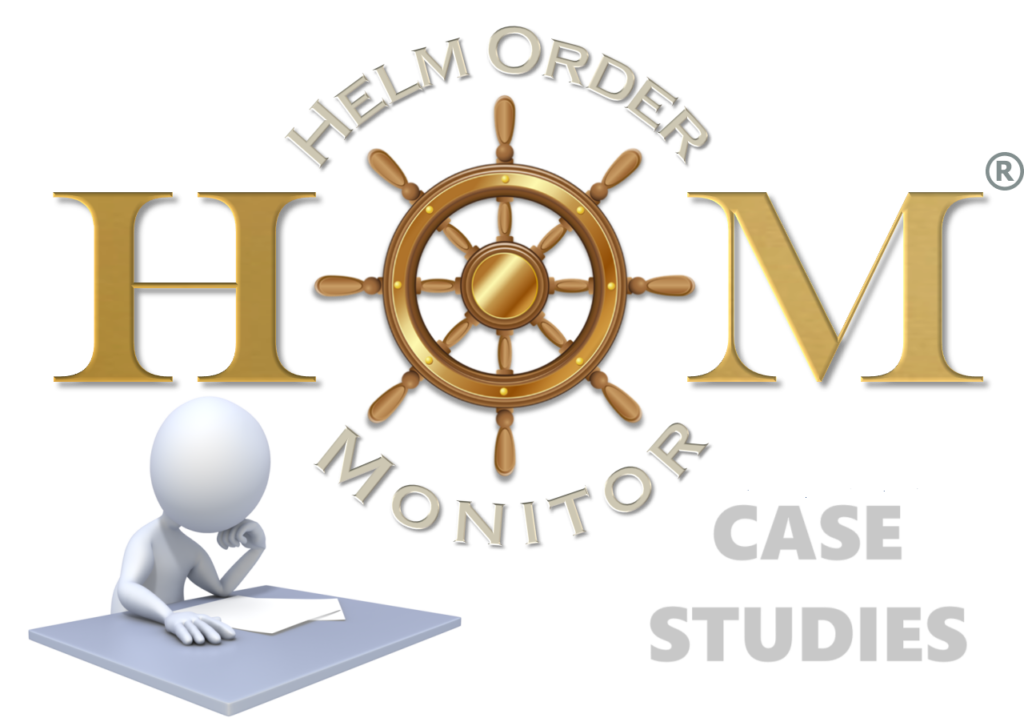
Case-Study Hub – From Helm-Control Mismatches to Human-State Risks
Here you’ll find real accidents re-told through the lens of Helm Order Monitor (HOM). Each story begins with a single helm command gone wrong; the commentary then shows how today’s system would have interrupted the chain—whether by warning that manual steering wasn’t really engaged, flagging a wheel turned the wrong way, or flashing a banner when bridge-team stress or fading awareness crossed a critical line.
Because many flag-state reports remain closed, we rely on added evidence from mariners and investigators. If you know of a collision, grounding or near-miss where a helm-order mismatch or bridge-team stress played a role, please share it via the confidential form at the bottom of the page. Every submission tightens the data set—and helps the next watch team stay out of trouble.
Costa Concordia
Last 5 minutes before the impact
Costa Concordia Disaster
On 13 January 2012, whilst the Costa Concordia was in navigation in the Mediterranean Sea in favorable meteo-marine conditions with 4229 persons onboard, at 21:45 local time, the ship suddenly collided with the “Scole Rocks” at the Giglio Island. With the help of the chronological recordings taken from the official investigation report, we made an accurate reconstruction of the last five minutes on the navigational bridge of Costa Concordia before the impact.
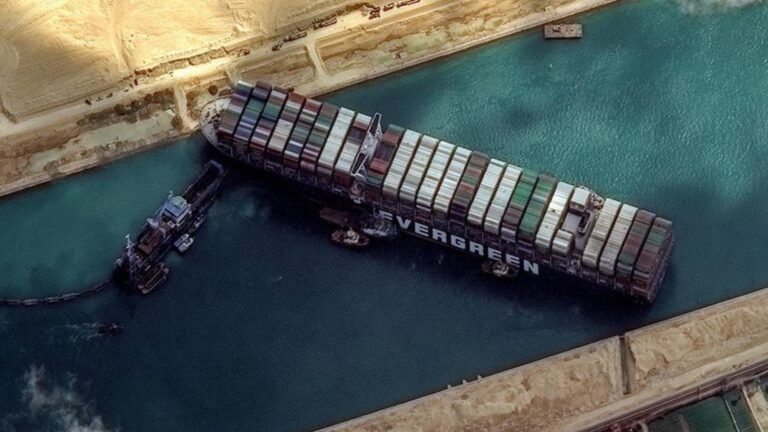
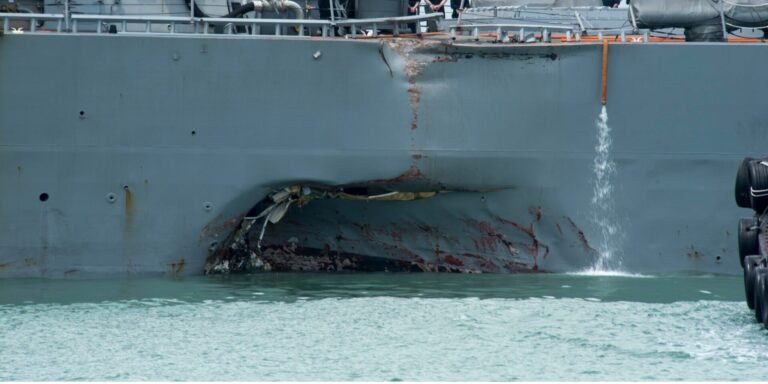
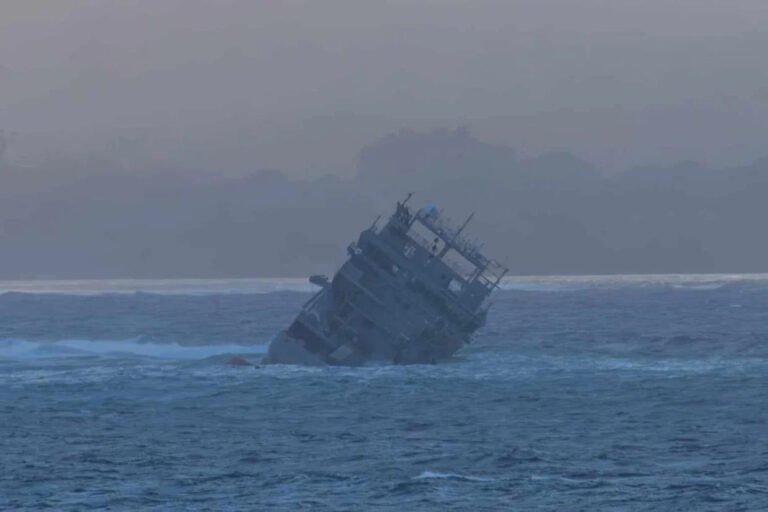
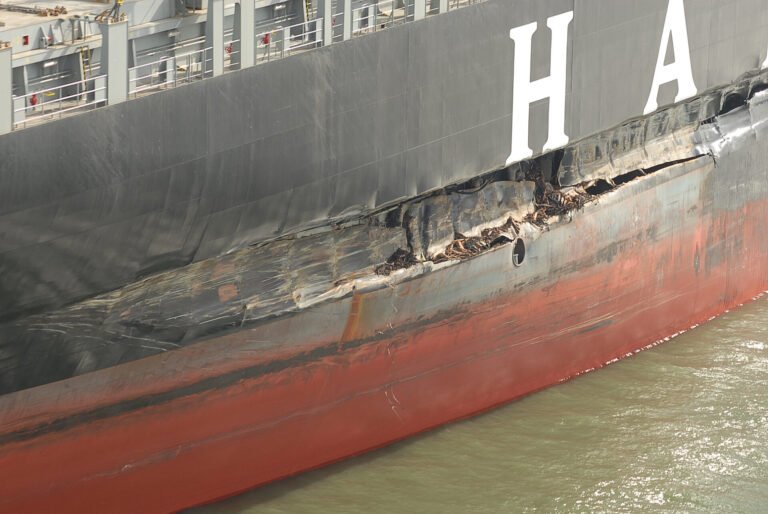
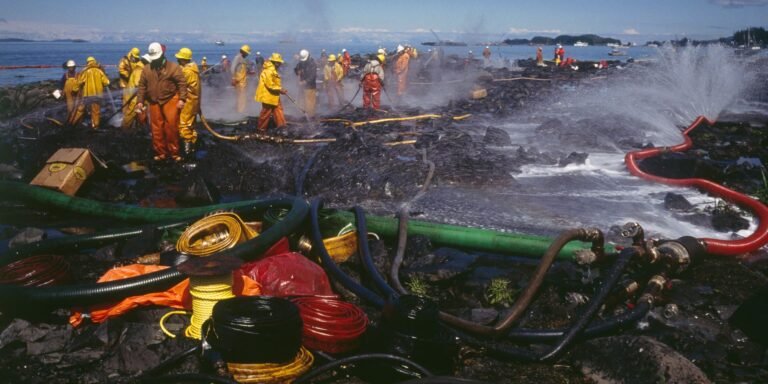
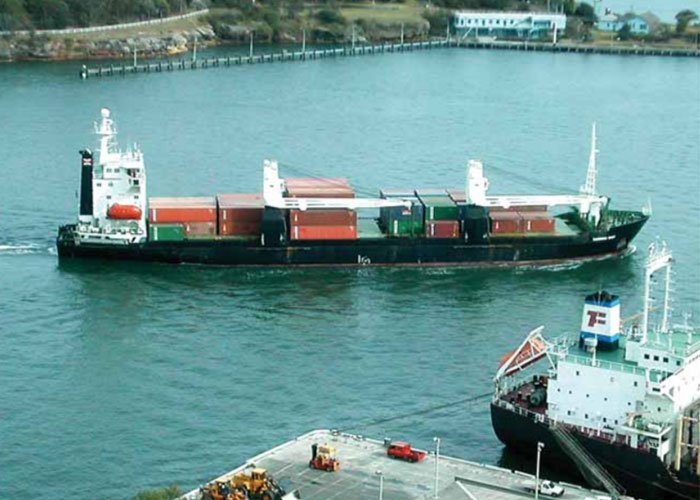
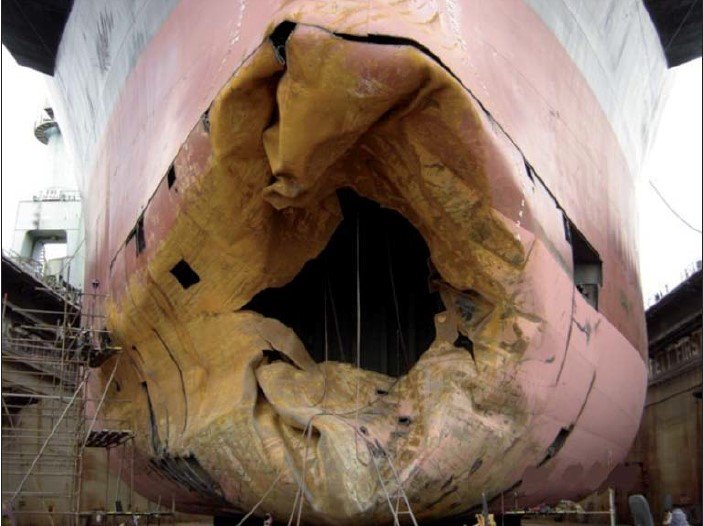
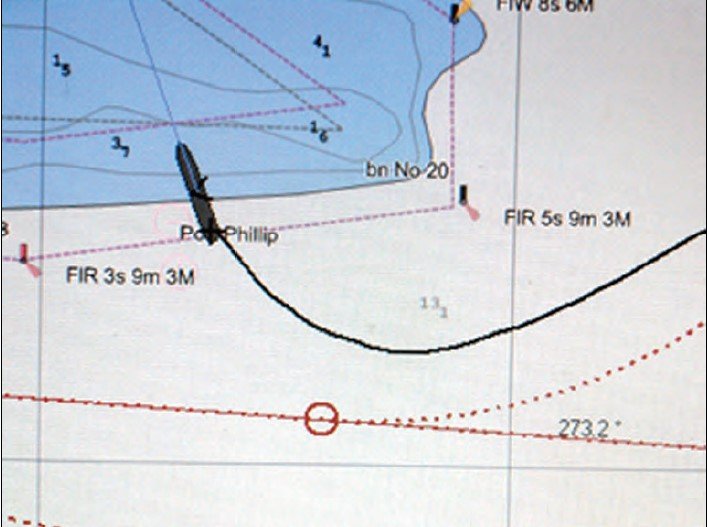
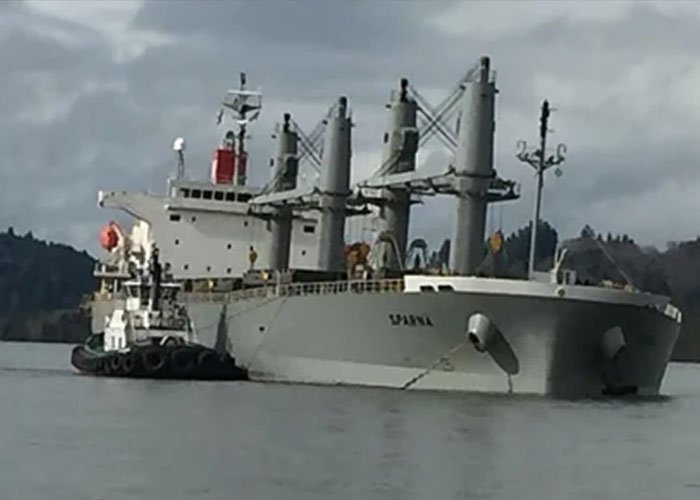
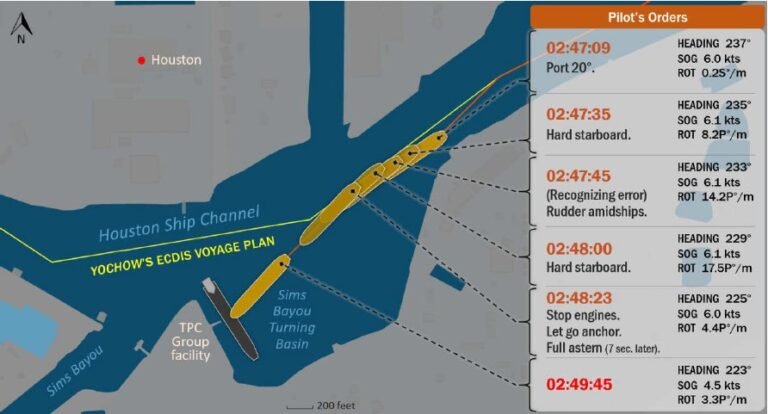
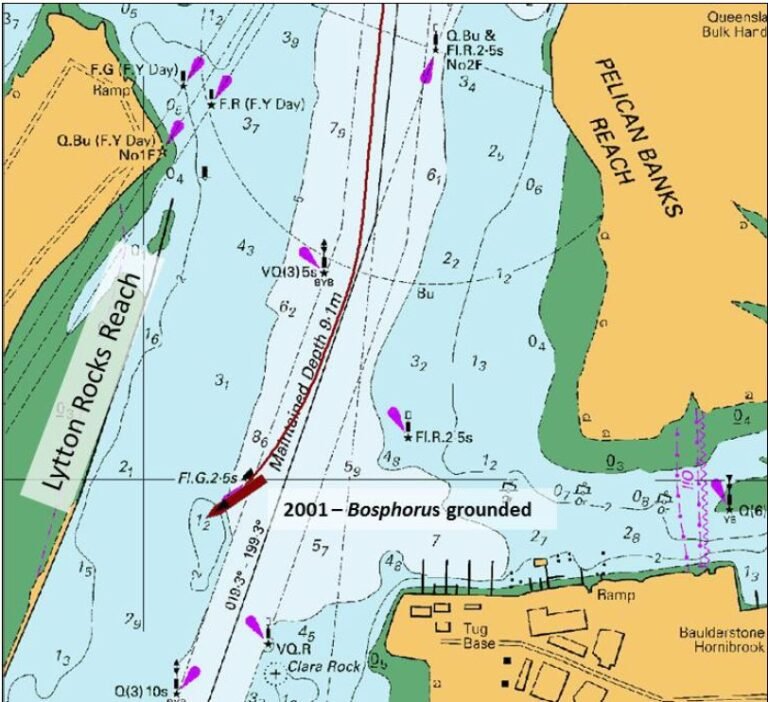
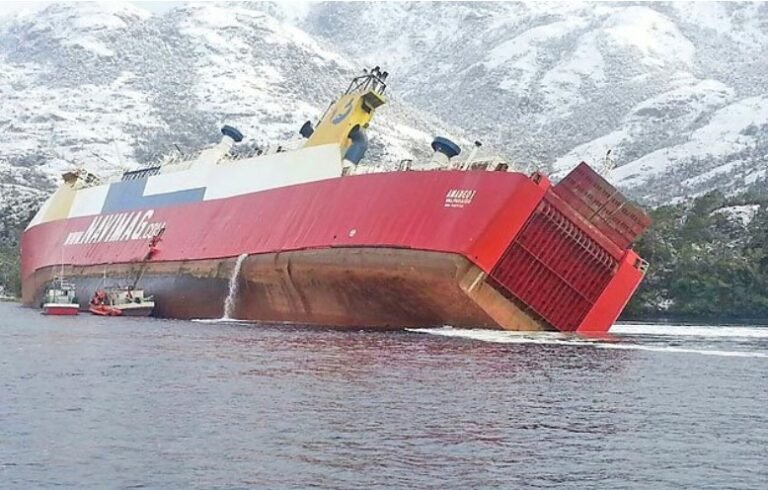
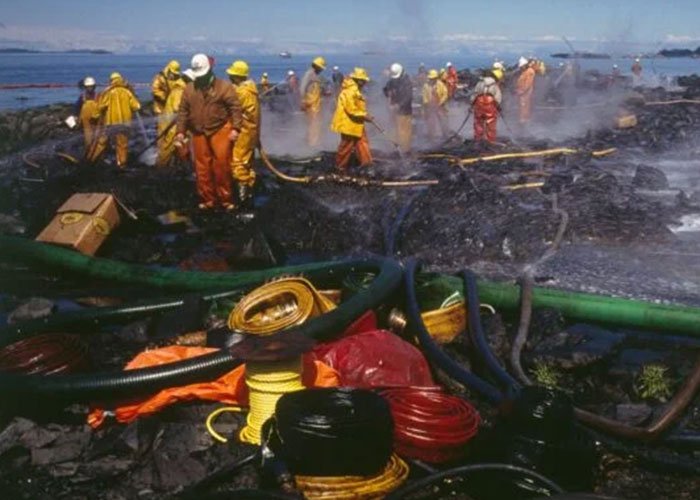
Grounding of MV Exxon Valdez
About 0009, on March 24, 1989, the U.S. tankship EXXON VALDEZ, loaded with about 1,263,000 barrels of crude oil, grounded on Bligh Reef in Prince William Sound, near Valdez, Alaska. At the time of the grounding, the vessel was under the navigational control of the third mate. There were no injuries, but about 258,000 barrels of cargo were spilled when eight cargo tanks ruptured, resulting in catastrophic damage to the environment. In 1989, the Exxon Valdez oil spill was the biggest environmental disaster in history. Damage to the vessel was estimated at $25 million, and the cost of the cleanup of the spilled oil during 1989 was about $1.85 billion. Although the third mate testified that he ordered the rudder increased from right 10° to right 20° rudder about 1 1/2 minutes after ordering the right 10° and then ordered the rudder increased to hard right about 2 minutes later, this sequence of rudder orders could not be substantiated using the course recorder trace.

Grounding of MV Tauranga Chief
Tauranga Chief arrived at Sydney from Port Kembla on 17 January 2003 on its normal liner route. It had sailed from Port Kembla the previous evening and arrived at the Sydney pilot boarding ground on schedule at 0300 local time. The pilot boarded as planned and the ship continued inwards toward the booked berth at White Bay container terminal. When the ship came to an intended course alteration position in the harbour, east of Bradleys Head, the pilot initiated the turn to starboard to round the headland. He firstly ordered 5° starboard rudder and, when the ship did not respond quickly enough, he increased the order to starboard 10°. The rate of swing increased markedly and so the pilot ordered port 20° to slow the swing. The seaman on the wheel made an error executing this last wheel order and instead applied starboard 20° wheel. Before the consequences of this error could be corrected, the ship ran aground on a mud/sand patch just south of the light on the southern end of the headland.

Grounding of MV Crimson Mars
At 1400 on 1 May 2006, Crimson Mars sailed, nearly fully loaded, from Bell Bay with a local pilot on board. The sky was cloudy, visibility was clear with a light southeasterly wind and the tide was flooding. The helmsman was steering the ship as instructed by the pilot. The master and third mate were also on the ship’s bridge for the pilotage passage.The passage progressed as intended until about 1440 when a turn to port around Garden Island was being executed. During the turn, starboard instead of port helm was applied for approximately one minute and a turn to starboard developed. By the time maximum port helm was applied at 1441, the grounding of the ship was inevitable. Soon after, the pilot ordered both anchors to be let go and the main engine to be run at emergency full astern in an attempt to reduce the effects of the impact. At 1442, Crimson Mars grounded on Long Tom Reef and shuddered to a stop as the port anchor was let go and the main engine was run astern.

Grounding of MV Francoise Gilot
At 0235 on 9 May, a Port Phillip pilot boarded the ship for its departure. At 0539, in order to slow the rate of starboard turn, the pilot ordered 5° port rudder. However, the rate of turn to starboard increased so he ordered 10° port rudder, and then 20° port rudder. This was followed by an order of hard-to-port. On each occasion, the helmsman correctly repeated the pilot’s orders but applied starboard helm. Consequently, the ship’s rate of turn to starboard rapidly increased. At 0540, when they realized that the rudder was at hard-to-starboard, both the master and pilot yelled ‘hard-to-port’ to the helmsman. The helmsman then applied the correct helm. The ship, however, was still turning to starboard and grounding was imminent. At about 0541, despite various engine and rudder movements, Francoise Gilot grounded between beacons 18 and 20; about half the ship’s length passed over the toe line 4 of the channel before it came to a complete stop.

Grounding of MV Sparna
Just before midnight on March 20, 2016, the bulk carrier Sparna was transiting outbound on the Columbia River when it departed the navigation channel and struck a rocky shallow area. The pilot ordered starboard 20 degrees. The helmsman acknowledged with “starboard twenty.” However, the rudder, which was still moving from the previous hard-to-port position toward midship, then began moving back to port, ultimately reaching port 20 degrees. Next, at 2335, the pilot requested slow-ahead speed. Immediately thereafter, the helmsman replied, “Rudder starboard twenty, sir.” However, the rudder was still at port 20 degrees. Neither the pilot nor the bridge team noticed the helmsman’s error. Seconds later, the pilot shouted, “Hard to starboard! Hard to starboard!” and ordered full-ahead speed. The helmsman replied, “Rudder coming hard to starboard now, sir.” At 2337, the Sparna VDR recorded a series of bangs, vibration noise, and the water speed decreasing from 8.5 knots to 3.5 knots as the vessel struck a charted shallow rock area just off the wood chip dock.
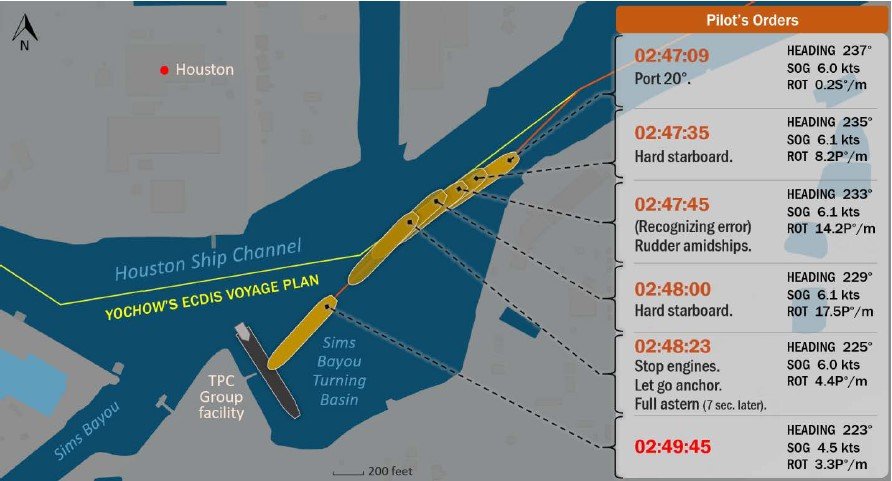
Collision of MV Yochow with ATB
At 0250 local time on June 13, 2018, the inbound bulk carrier Yochow collided with the articulated tug and barge OSG Independence/OSG 243, which was moored at the TPC Group, Inc. facility on the Houston Ship Channel in Houston, Texas. The pilot on Yochow planned to turn wide at Sims Bayou, intending to stay to the south side of the channel to pass the dredge MBI 05 operating in the channel just past the turn. He ordered “hard starboard” to make the turn. The helmsman repeated the pilot’s order but immediately put the rudder hard to port. Ten seconds later, the pilot recognized the error and ordered midships while tapping with his fingers on the rudder angle indicator above his head to get the helmsman’s attention. It took the steering gear 15 seconds to shift from hard port to midships, and then the pilot repeated his original hard-starboard order. The rudder reached hard starboard 12 seconds later, although the ship’s heading was still falling to port at about 12 degrees per minute. With the port anchor and two shots of chain deployed, the Yochow collided at approximately 4.5 knots with the port side of the tank barge OSG 243 amidships at 02:49:45.
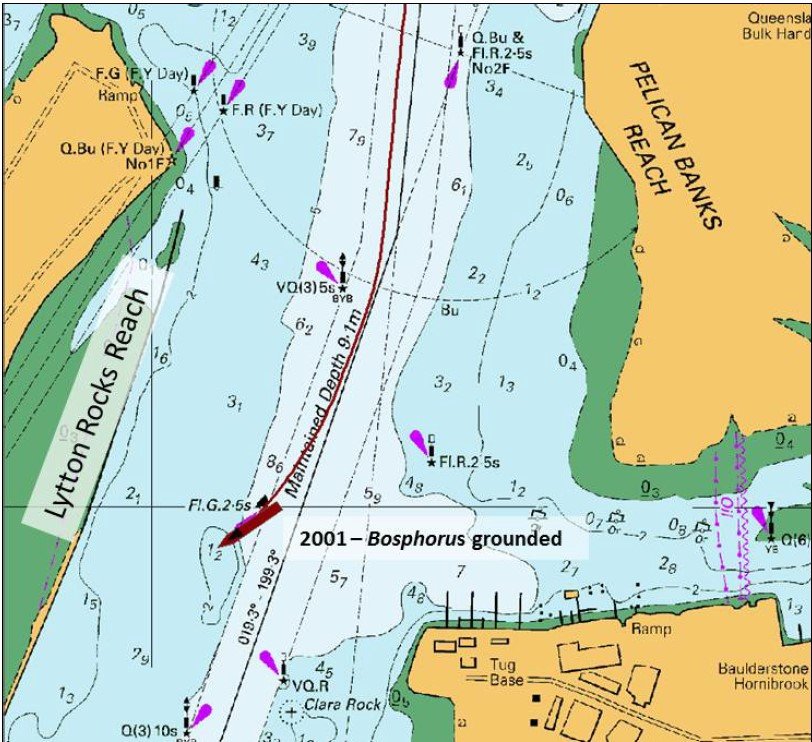
Grounding of MV Bosphorus
At about 20:00 on 29 October 2013, the general cargo ship Bosphorus grounded at Lytton Rocks Reach in the Brisbane River after the ship’s helmsman unintentionally put the helm the wrong way. At about 20:00, the pilot aboard the general cargo ship Bosphorus observed that the ship was not steady but swinging to starboard towards shallow water. He ordered ‘midships’ immediately followed by ‘port 10’. The helmsman responded verbally with ‘port 10’ but instead applied 10° of starboard helm. The pilot then ordered ‘port 20’ and then ‘hard to port’. Each time the helmsman repeated the order but applied starboard helm. Within 9 seconds, the pilot noticed that the wheel was still to starboard and then shouted ‘you’re going to starboard’. The third mate then intervened and swung the wheel hard to port. At 20:01, Bosphorus grounded at the Lytton Rocks Reach Channel.
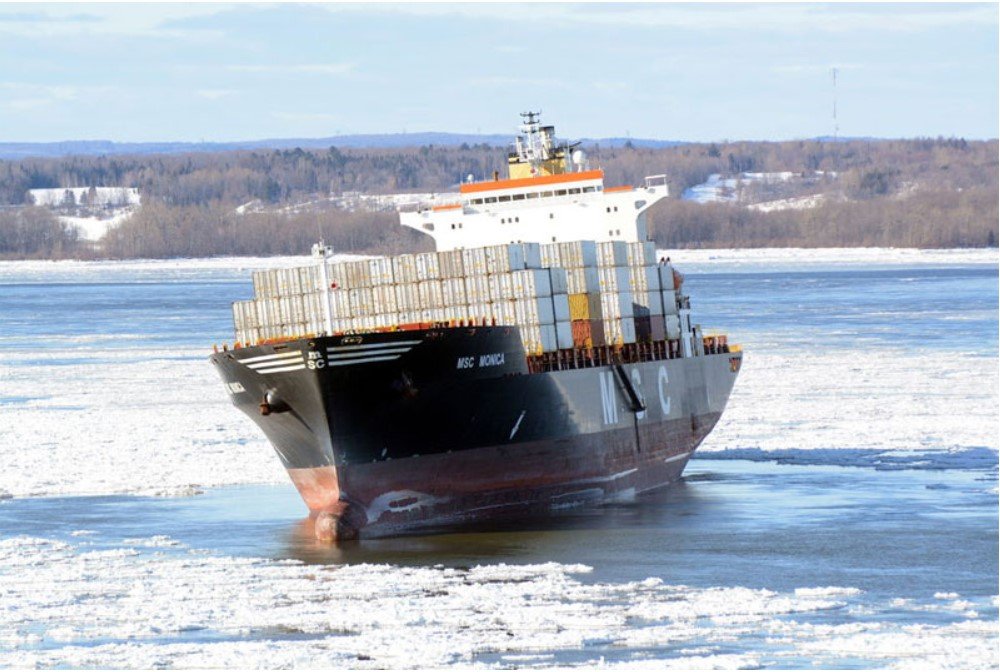
Grounding of MV MSC Monica
While navigating the St. Lawrence River downbound, the MSC Monica unexpectedly veered to starboard, exited the buoyed channel, and ran aground. Testing and examinations established that the steering gear and its control system were fully functional and that no steering failure occurred. The winds and current were not strong enough to cause the vessel’s path to change, and the vessel’s speed was not excessive for this particular type of vessel in this section of the river. The Centre for Marine Simulation (CMS) simulator was used to reproduce several scenarios under the same conditions at the time of the occurrence. The results demonstrated that the most plausible scenario for causing the vessel to initiate a veering to starboard with a rate-of-turn (ROT) of 12° per minute was that the helm was originally positioned at 10° to starboard, while the course had to be maintained at 085°gyro (G). The helmsman at the time had the expectation that the helm was positioned at 10° to port. Because the intent was to maintain the course and not veer to starboard, the initial deviation from the course was due to the helm likely being inadvertently placed 10° to starboard.
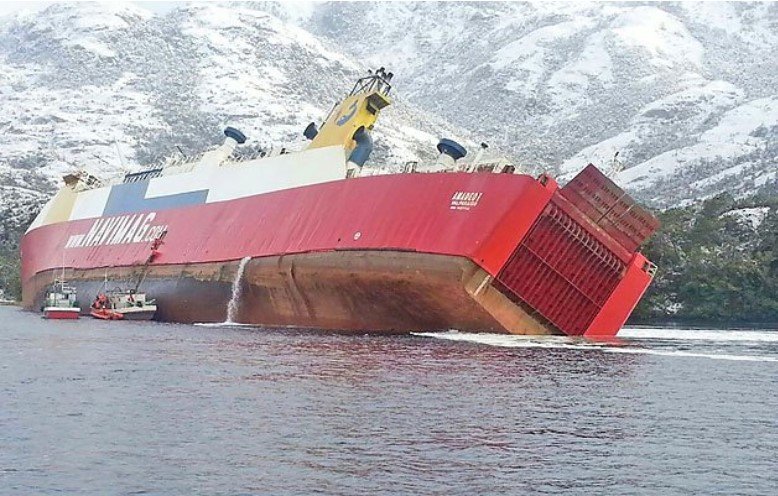
Grounding of Ferry Amadeo I
On August 18, 2014, the 132-meter-long ro-ro cargo ferry Amadeo I ran aground at Paso Kirke, Chile. Cause: helmsman error. The ferry departed from Puerto Natales with 17 passengers and 28 crew, along with a cargo of 700 cattle bound for Puerto Montt. Around 10 am, after the helmsman inadvertently put the rudder on the wrong side, the Amadeo I struck an islet at Merion, resulting in a crack in the hull on the starboard side. The rupture caused substantial uncontrolled flooding into the cargo deck and engine room, putting the vessel at risk of sinking. The master of the vessel decided to run the vessel aground before it could sink. The Amadeo I reached shore and put the bow on the beach. Authorities arrived on the scene with rescue boats and safely transferred 17 passengers and 18 crew. Ten crew remained on board, attempting to bring the flooding under control. Unfortunately, the flooding continued, and the Amadeo I heeled over 60 degrees onto her starboard side. By 5 am the following day, the crew had to abandon their efforts and were taken off the ferry. The ferry later capsized onto her side, and the stern section of the vessel sank.
Have information about a related incident?
Investigation files rarely spell out “helmsman error” or flag lapses such as mounting stress or fading alertness—and many flag states keep the full reports locked away, so crucial details never reach the public.
We want to close those knowledge gaps. If you know of a collision, grounding, or near-miss where any of the cues above would have mattered, please share what you can through the confidential form. We publish no names or identifying data.